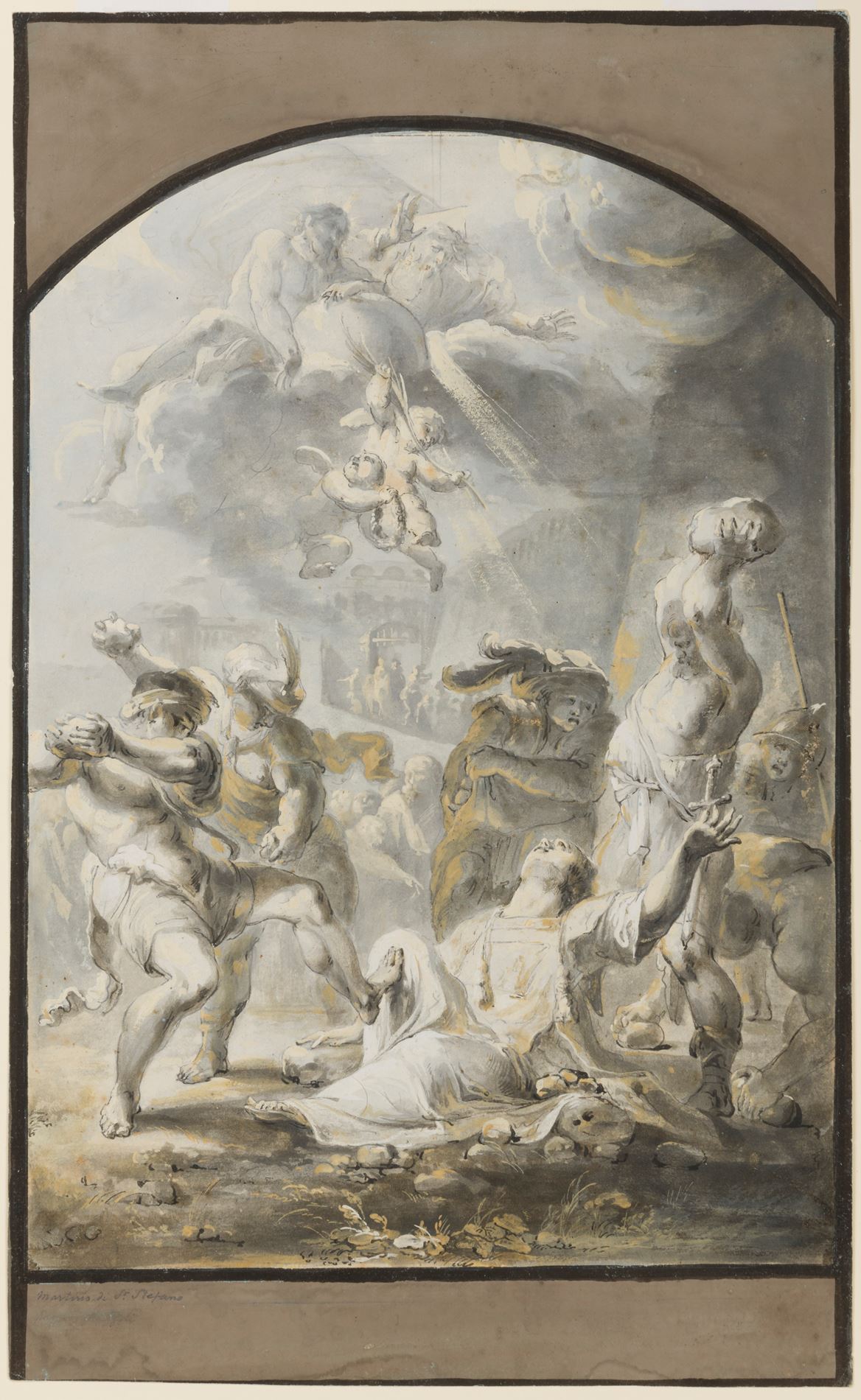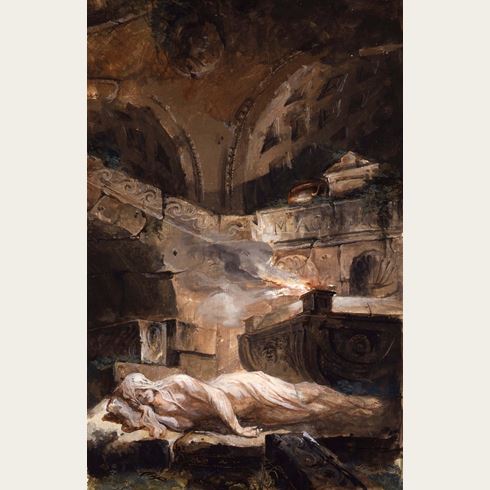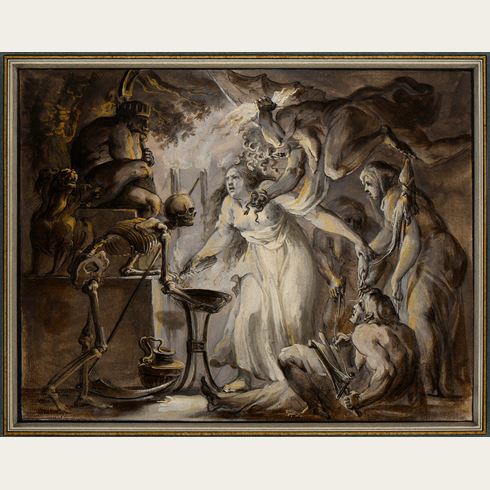Giovanni DAVID
(Cabella Ligure 1743 - Genoa 1790)
The Stoning of Saint Stephen
Sold
Pen and grey ink and grey and brown wash, heightened with white and touches of yellow, over an underdrawing in black chalk, on paper washed brown, within a fictive drawn mount with a border in black ink.
Inscribed Martirio di So. Stefano in the lower left margin.
341 x 241 mm. (13 1/2 x 9 1/2 in.) [image]
410 x 252 mm. (16 1/8 x 9 7/8 in.) [sheet]
Inscribed Martirio di So. Stefano in the lower left margin.
341 x 241 mm. (13 1/2 x 9 1/2 in.) [image]
410 x 252 mm. (16 1/8 x 9 7/8 in.) [sheet]
Apart from the contents of two albums at Windsor Castle, relatively few drawings by Giovanni David are known today, numbering only around forty sheets in total. Many of his surviving drawings are highly finished works and are a testament to the creative powers of the artist, whose drawings, as the scholar Mary Newcome Schleier has noted, are characterized by ‘strong contrasts of light and dark and areas of intricate detail. Whether he sketched components of his compositions with free, circular lines, or minutely described them with colored wash and white heightening, David succeeded in formulating some of the most complex, imaginative scenes to be found in Genoese art in the late eighteenth century.’
This drawing is a preparatory study, with several differences, for the large altarpiece - commissioned by Giacomo Durazzo and bearing the arms of the Durazzo family – placed on the high altar in the parish church of Santo Stefano in Larvego, north of Genoa. Dated 1777, the painting of The Stoning of Saint Stephen was commissioned from Giovanni David as part of the reconstruction of the church, financed by Giacomo’s brother Marcello Durazzo, that had begun in 1772, following the damage caused during the Austrian siege of Genoa in 1747. The Stoning of Saint Stephen is David’s first recorded work in Genoa and Liguria, and the present sheet is thus significant as one of the few securely datable drawings by this fascinating artist.
The first owner of this drawing was in all likelihood David’s patron Count Giacomo (or Jacopo) Durazzo (1717-1794), a noted diplomat and one of the most important print collectors of the 18th century, who served as the Genoese ambassador at the court of Vienna and later as the Imperial ambassador in Venice. During his tenure in Vienna, which lasted some fifteen years, he was given charge of all the theatres in the city. That a large number of David’s drawings once belonged to Giacomo Durazzo is demonstrated by the fact that some 156 drawings and watercolours (and possibly prints) by the artist, with this drawing probably among them, were included in the posthumous sale of Durazzo’s collection, held in Stuttgart in November 1872.
This drawing is a preparatory study, with several differences, for the large altarpiece - commissioned by Giacomo Durazzo and bearing the arms of the Durazzo family – placed on the high altar in the parish church of Santo Stefano in Larvego, north of Genoa. Dated 1777, the painting of The Stoning of Saint Stephen was commissioned from Giovanni David as part of the reconstruction of the church, financed by Giacomo’s brother Marcello Durazzo, that had begun in 1772, following the damage caused during the Austrian siege of Genoa in 1747. The Stoning of Saint Stephen is David’s first recorded work in Genoa and Liguria, and the present sheet is thus significant as one of the few securely datable drawings by this fascinating artist.
The first owner of this drawing was in all likelihood David’s patron Count Giacomo (or Jacopo) Durazzo (1717-1794), a noted diplomat and one of the most important print collectors of the 18th century, who served as the Genoese ambassador at the court of Vienna and later as the Imperial ambassador in Venice. During his tenure in Vienna, which lasted some fifteen years, he was given charge of all the theatres in the city. That a large number of David’s drawings once belonged to Giacomo Durazzo is demonstrated by the fact that some 156 drawings and watercolours (and possibly prints) by the artist, with this drawing probably among them, were included in the posthumous sale of Durazzo’s collection, held in Stuttgart in November 1872.
Only a handful of paintings, frescoes and drawings survive from the brief career of Giovanni David, a Genoese artist succinctly described by his biographer Federico Alizeri as ‘with few known works, a bizarre style, and an obscure, almost mysterious life’. David studied with Domenico Corvi in Rome in the early 1770s, assisting him in such works as the fresco decoration of the Palazzo Borghese, and winning a first prize at the Accademia di San Luca in 1775. He spent some time in Naples and in Venice before returning to Genoa at the end of the 1770s. There he entered the service of the Genoese count Giacomo Durazzo, who had earlier sponsored David’s artistic training and who was to be his protector and chief patron throughout his career. Indeed, David was the artist-in-residence for the Durazzo family for much of his life. He executed a number of paintings for Genoese churches, including Santa Maria in Carmine, the convent of Santa Maria in Rifugio and Santa Maria delle Vigne, although little remains of one of his last major projects, the decoration of the Genoese church of Sant’Agnese.
Although he worked mainly in Genoa, where he lived in the Palazzo Durazzo, David also spent some time in Venice between 1775 and 1776, when he produced a large number of prints of allegorical, literary and genre subjects, as well as reproductive etchings after the work of earlier artists, including Andrea Mantegna, Jacopo Bellini and Giulio Romano. Many of his prints seem to have been commissioned by Giacomo Durazzo, or were dedicated to him. It was during his brief stay in Venice that David worked as a scene painter at the theatre of La Fenice, probably also at the instigation of Durazzo. Back in Genoa, David received one of his most important secular public commissions, for two lunette paintings for the Sala del Maggior Consiglio of the Palazzo Ducale, completed in 1780. David is known to have travelled to France, the Low Countries and England between September 1785 and October 1786; a trip recorded in a pair of albums containing around 180 topographical drawings which were at one time in the collection of the 19th century Genoese sculptor Santo Varni and are today in the Royal Library at Windsor Castle. One of David’s final projects was the design of a catafalque in honour of Carlo III de’Bourbon, erected in the church of San Lorenzo in 1789, a year before the artist’s death at the relatively young age of forty-one.
Although he worked mainly in Genoa, where he lived in the Palazzo Durazzo, David also spent some time in Venice between 1775 and 1776, when he produced a large number of prints of allegorical, literary and genre subjects, as well as reproductive etchings after the work of earlier artists, including Andrea Mantegna, Jacopo Bellini and Giulio Romano. Many of his prints seem to have been commissioned by Giacomo Durazzo, or were dedicated to him. It was during his brief stay in Venice that David worked as a scene painter at the theatre of La Fenice, probably also at the instigation of Durazzo. Back in Genoa, David received one of his most important secular public commissions, for two lunette paintings for the Sala del Maggior Consiglio of the Palazzo Ducale, completed in 1780. David is known to have travelled to France, the Low Countries and England between September 1785 and October 1786; a trip recorded in a pair of albums containing around 180 topographical drawings which were at one time in the collection of the 19th century Genoese sculptor Santo Varni and are today in the Royal Library at Windsor Castle. One of David’s final projects was the design of a catafalque in honour of Carlo III de’Bourbon, erected in the church of San Lorenzo in 1789, a year before the artist’s death at the relatively young age of forty-one.
Provenance
Probably Giacomo Durazzo, Genoa, and thence by family descent until the Durazzo sale, Stuttgart, H. G. Gutekunst, 19 November 1872 onwards, as part of lot 4195 (‘156 Bl. Bleistiftszeichnungen, Aquarelle etc. von Giovanni David, geb. zu Sampier d’Arena 1743, gest. zu Genua 1790. Schöne Sammlung.’)
Marvin S. Sadik, Falmouth, Maine
Anonymous sale, London, Christie’s, 5 July 1994, lot 61
P. & D. Colnaghi, London, in 1995
Private collection.
Marvin S. Sadik, Falmouth, Maine
Anonymous sale, London, Christie’s, 5 July 1994, lot 61
P. & D. Colnaghi, London, in 1995
Private collection.
Literature
Carmen Bambach and Nadine Orenstein, Genoa: Drawings and Prints, 1530-1800, exhibition catalogue, New York, 1996, p.55, under no.61; Mary Newcome Schleier and Giovanni Grasso, Giovanni David: Pittore e incisore della famiglia Durazzo, Turin, 2003, pp.28-29, no.D8, p.30, under no.D9, and p.32, under no.D10; Clifford S. Ackley, ‘The Intuitive Eye: Drawings and Paintings from the Collection of Horace Wood Brock’, in Horace Wood Brock, Martin P. Levy and Clifford S. Ackley, Splendor and Elegance: European Decorative Arts and Drawings from the Horace Wood Brock Collection, exhibition catalogue, Boston, 2009, p.99 and p.157, no.127, illustrated p.126; Linda Wolk-Simon and Carmen C. Bambach, An Italian Journey. Drawings from the Tobey Collection: Correggio to Tiepolo, exhibition catalogue, New York, 2010, p.228, note 8, under no.72.
Exhibition
New York and London, Colnaghi, Master Drawings, 1995, no.39; Stanford University, Cantor Center for Visual Arts, Classic Taste: Drawings and Decorative Arts from the Collection of Horace Brock, March-May, 2000; Boston, Museum of Fine Arts, Splendor and Elegance: European Decorative Arts and Drawings from the Horace Wood Brock Collection, 2009, no.127.







